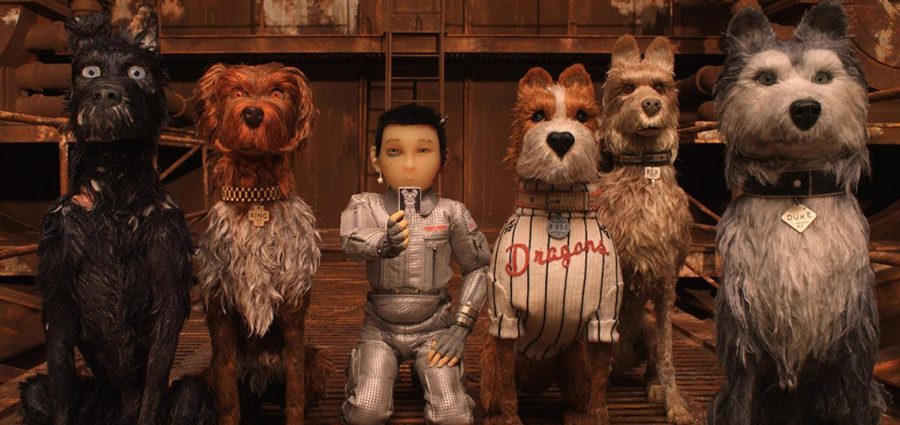A dazzling dystopian dog film
Directed by Wes Anderson, “Isle of Dogs” was released on March 23 and has received a 91 percent approval rating on Rotten Tomatoes.
Apr 19, 2018
Combining his love for visually inventive animation, deadpan humor and, well, dogs, director Wes Anderson (“Rushmore,” “Moonrise Kingdom,” “The Grand Budapest Hotel”) may have made his most effortlessly enjoyable film to date.
“Isle of Dogs” is set in a dystopian Japan in which all dogs have been banished to a nearby island after an illness known as “snout fever” has spread among the archipelago’s canines.
The film follows a young boy named Atari who travels to the titular isle in hopes of finding his dog Spots, who was banished several months earlier.
Although “Isle of Dogs” is an ostensibly heartwarming comedy about the love between a boy and his dog, it is also arguably Anderson’s most politically charged film in his career.
Indeed, the beloved auteur takes care to inject a number of startling parallels in his seemingly saccharine storybook between the characters therein and the actions taken by real-life world leaders of both the past and present day.
What results is a singular piece of filmmaking that is as predictably steeped in Anderson’s unique aesthetic vision as it is refreshingly fearless in its willingness to take on political opponents — both large and small.
Directing: 5/5
For “Isle of Dogs,” Anderson returned to the same stop-motion animation style he employed in his 2009 Academy Award-nominated film “Fantastic Mr. Fox.”
Nine years later, Anderson has only seemed to improve at his ability to craft inimitable masterworks of visual beauty with an impeccable eye for detail.
Everything from the loose strands of fur on the miniature mutts’ muzzles to the mountains of trash piled high on the dogs’ eponymous island is beautifully rendered by hand, with each and every frame of Anderson’s film serving as an absorbing window into the director’s obsessive creative process.
Beyond the film’s immaculately executed animation, Anderson’s camera retains many of the filmmaker’s trademark visual cues that have been established throughout his filmography.
Opting for symmetrical compositions, snap-zooms and long lateral tracking shots, Anderson allows his camera to freely move about his imaginatively minuscule landscape with the same idiosyncratic tendencies for which he has become so recognizable.
Writing: 5/5
The story of “Isle of Dogs” is at once comfortably familiar and shockingly daring.
To tell his story, Anderson borrows many of the best aspects of the archetypal hero’s journey, especially as it relates to the young Atari’s search for his long-lost pup.
However, Anderson elegantly elevates the otherwise conventional narrative beats of his film through endearing characterizations, genuinely surprising reveals and the aforementioned use of politically charged symbols.
In particular, Anderson positions his expelled pooches as the socially oppressed minority of the dystopian Japanese culture in which he situates his film — drawing implicit parallels to the Holocaust and even more recent acts of mass slaughter, such as the Cambodian and Rwandan genocides.
Now, drawing such grisly parallels could have very well compromised Anderson’s distinctive humor, which, in the hands of a lesser filmmaker, would have likely resulted in an incredibly downbeat and, ultimately, ineffective outing.
Fortunately, Anderson is able to find the perfect balance between quirky charm and social commentary to create an exceptionally well-paced animated adventure that is just as entertaining as it is thought-provoking.
Acting: 5/5
As is typical with any Wes Anderson film, the acting in “Isle of Dogs” is decidedly muted in an effort to underscore the screenplay’s deadpan humor.
Despite the intentionally subdued delivery of much of the dialogue, though, many of the characters still convey a great degree of emotional resonance — thanks, in large part, to the star-studded cast of considerably talented voice actors featured in the film.
Bryan Cranston deserves particular praise as Chief, a stray dog who reluctantly joins Atari on his journey. Cranston, who is likely best known for his volatile role as Walter White in the acclaimed television series “Breaking Bad,” brings the same acerbic wit to his quadrupedal character — as well as a surprising amount of warmth.
Next, Bill Murray and Edward Norton should rightly be singled out for their portrayals of Boss and Rex, respectively. Both actors have frequently collaborated with Anderson in the past, and the two veterans are quietly funny — and ridiculously cute — as their canine counterparts.
Lastly, it should be noted that Greta Gerwig delivers an inspired performance as Tracy Walker, the strong-willed foreign exchange student who aids Atari in finding a cure for “snout fever.”
Overall: 5/5
Now 22 years removed from his directorial debut, Anderson has not missed a step in crafting some of the most visually intoxicating and unabashedly eccentric films of the past quarter century.
With its eye-popping animation, talented voice acting and heartwarming tale of oddballs and misfits, “Isle of Dogs” has all the makings of another Anderson classic — proving, once and for all, that the acclaimed director is truly one of the top dogs in moviemaking today.









